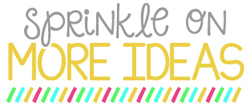Have you heard of Seesaw?
Seesaw is a digital journal for students to share their work with only their families and their teacher. i started using is 2 years ago in my Kindergarten classroom and I have embraced it more each year. There is SOOOOO much it can do so I wanted to share some ideas of how I have utilized this amazing tool with apps and with general student sharing. I have found that parents LOVE it because they can see all the creative work we do in class, since most of this creative work will never go home. It also allows us to use apps to show what we know and share those tech tools for learning with our families, since we can't take our iPads home.
In Writer's Workshop, our most recent unit of study is procedural text, how-to stories, so we learned about the app Popplet.
This app is awesome for creating thinking maps. We used the app to create a flow map of how to build a leprechaun trap.
Once students created a flow map, they saved it to their iPad, then uploaded it to Seesaw using the ADD FILE feature.
After the image from Popplet was uploaded, then students could explain their work so parents could see the flow map and hear their child explaining it. Click
here to view the above Popplet on Seesaw.
After we wrote how to build leprechaun traps, then we built them!
After building them, we uploaded a video explaining our work. Click the image below to see the video explaining one of our traps.
Another app we LOVE is Chatterpix.
Chatterpix is amazing! It allows students to snap a picture, then animate the picture by drawing a mouth and recording words. Here are some fun examples of Chatterpix in our classroom. Click each picture below to see the video on Seesaw.
Biography of Martin Luther King Jr.
Each student was given a shape and created that shape as a shape penguin and explained the attributes of that shape.
Students created a quadrilateral and explained the attributes.
Persuasive writing about turkeys in disguise
The next app that we use often is called Adobe Spark. We use this app for so much, that I think it deserves it's own post soon....
Its a great app for students to snap a picture, then record an explanation. It creates a trail of images with explanations. Here is an example that was uploaded to Seesaw. Students were placed in groups and given a prefix, then created an Adobe Spark video describing the words they decided upon that had that prefix. Click the image below to take a look at one prefix video example.
DoInk is a green screen app that we use as well, then we add our saved green screens to Seesaw so families can view them.
Here is my kindergarten class from last year creating their own version of Gingerbread Man to tell with Green Screen, then upload to Seesaw so families can see their awesome work.
Here is my current class of second graders building pieces to retell Stellaluna in groups of 3-4 students.
Once they finished, they uploaded to Seesaw so their families could see and I could assess their retell components. Click below to see one groups' work.
Apart from using apps, Seesaw is just great for sharing what we know in creative ways and for families to see our work.
We can share our writing. Click each Seesaw image to view it.
Here is one of our bat pop up books.
Here is one of our pumpkin monsters after reading I Need My Monster. This one is just an photo, not a video.
Here is a published penguin book from our research project.
We used Shelia Rae, the Brave to learn about adjectives that describe character traits by making a mask in which our faces went in the middle and we wrote words to describe Shelia Rae. Then we read these on Seesaw.
We built gingerbread houses with place value blocks, then added up the value of our house based on the blocks used.
Here we did retelling of The Dot with a puppet and our retell ribbon.
(You can grab the retell ribbon for FREE
here.
)
You can also use many amazing tools already built into Seesaw, including their very large Activity Library.
Teachers can search for ideas that are ALREADY MADE, and add them to all students' journals to complete, OR select certain students to complete assignments, allowing differentiation.
Click below to see a Seesaw activity in which students showed they understood common and proper nouns and explained how they knew using examples they created.
Seesaw also has drawing tools that allow students to draw on a photo, and record their thinking at the exact same time their drawings appear. Click to see these two students sharing the clock they built and their skip counting on the clock.
Another way I use Seesaw is for students to send me their thinking, so I can see it, then I can choose to delete it. This is great for exit tickets and for permission to go to the Breakout Box. (Click
here to read how I use Seesaw with Breakout Boxes.) Once I see their explanations, I simply discard it. There isn't a need for parents to see everything, especially if it's a quick assessment for me to see if they understood a concept or need more practice.
How can you use Seesaw in your classroom?
























































































